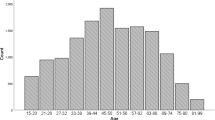Abstract
Research over several decades about subjective life satisfaction has led to the conclusion that the majority of people seem to be satisfied with their lives when their social and physical needs are met. In empirical studies which have used self-report instruments, this trend is reflected in respondents’ consistent preference for the positive end of scales. This led to the suggestion that there is a normative range for life satisfaction, which should hold true for general population data and, therefore, serve as a reference point, or a gold standard, for comparison (Cummins Social Indicators Research, 35, 179–200, 1995, Social Indicators Research, 43, 307–334, 1998). Subsequent research has shown that Western and non-Western samples generally conform to the normative range, but more data are needed from Chinese societies. In an attempt to remedy this situation, this paper investigates normative life satisfaction there. This paper reanalyses published and unpublished data from various Chinese societies (People’s Republic of China, Hong Kong, Macau, Singapore, and Taiwan) in order to confirm whether or not they lie within the normative range for non-Western countries. The results provide support for the relevance of Cummins’s normative range in Chinese societies. That the normative range generalised to the present study is a very useful finding, as it supports its utility for Chinese samples, and adds support to a theoretical explanation – i.e. the Wellbeing Homeostatisis theory—in Chinese groups.
Similar content being viewed by others
References
Biswas-Diener, R., Vittersø, J., & Diener, E. (2005). Most people are pretty happy, but there is cultural variation: The Inughuit, the Amish, and the Maasai. Journal of Happiness Studies, 6, 205–226.
Boucher, J., & Osgood, C. (1969). The Pollyanna hypothesis. Journal of Verbal Learning and Verbal Behaviour, 8, 1–8.
Chan, Y., & Lee, R. (2006). Network size, social support and happiness in later life: A comparative study of Beijing and Hong Kong. Journal of Happiness Studies 7(1), 87–112.
Cheung, C.-K., & Leung, K.-K. (2004). Forming life satisfaction among different social groups during the modernization of China. Journal of Happiness Studies, 5, 23–56.
Cheung, C., & Leung, K. (in press). Ways by which comparable income affects life satisfaction in Hong Kong. Social Indicators Research.
Cummins, R. (1995). On the trail of the gold standard for subjective wellbeing. Social Indicators Research, 35, 179–200.
Cummins, R. (1998). A second approximation to an international standard for life satisfaction. Social Indicators Research, 43, 307–334.
Cummins, R. (2003). Normative life satisfaction: measurement issues and a homeostatic model. Social Indicators Research, 64, 225–256.
Cummins, R. A., & Nistico, H. (2002). Maintaining life satisfaction: The role of positive cognitive bias. Journal of Happiness Studies, 3, 37–69.
Diener, E., & Biswas-Diener, R. (2000). New directions in subjective well-being research: The cutting edge. Indian Journal of Clinical Psychology, 27, 21–33.
Diener, E., & Diener, C. (1996). Most people are happy. Psychological Science, 7, 181–185.
Diener, E., & Suh, E. M. (Eds.) (2000). Culture and subjective well-being. Cambridge, MA: MIT Press.
Diener, E., Emmons, R., Larson, R., & Griffith, S. (1985). The satisfaction with life scale. Journal of Personality Assessment, 49, 71–75.
Gill, W. (1984). Monitoring the subjective well-being of chronically ill patients over time. Community Health Studies, 8, 288–296.
Goldings, H. (1954). On the avowal and projection of happiness. Journal of Personality, 23, 30–47.
Huang, L., & Xing, Z. (2005). An initial research on the wellbeing index applied to citizens in China. Chinese Journal of Behavioral Medical Science, l14(5), 464–465.
Ibrahim, M, & Chung, M. (2003). Quality of life of residents living near industrial estates in Singapore. Social Indicators Research, 61(2), 203–225.
International Wellbeing Group. (2006). Personal wellbeing index. Melbourne: Australian Centre on Quality of Life, Deakin University.
Keng, K. A., & Hooi, W. S. (1995) Assessing quality of life in Singapore: An explaratory study. Social Indicators Research, 35(1), 71–92.
Lau, A., Cummins, R., & McPherson, W. (2005). An investigation into the cross-cultural equivalence of the Personal Wellbeing Index. Social Indicators Research, 75, 403–430.
Le, Z., & Dou, Z. (2006). Wellbeing index study in Shenzhen, China. Shenzhen: Shenzhen Academy of Social Sciences.
Lu, L. (2001). Understanding happiness: A look into the Chinese folk psychology. Journal of Happiness Studies, 2, 407–432.
Lu, L., & Gilmour, R. (2004). Culture and conceptions of happiness: Individual oriented and social oriented SWB. Journal of Happiness Studies, 5, 269–291.
Macau Inter-University Institute (2007). Macau quality of life report 1. Macau: Macau Inter-University Institute.
Swinyard, W., Kau A.-K., & Phua H.-Y. (2001). Happiness, materialism, and religious experience in the US and Singapore. Journal of Happiness Studies, 2(1), 13–32.
Tiliouine, H., Cummins, R., & Davern, M. (2006). Measuring wellbeing in developing countries: The case of Algeria. Social Indicators Research, 75, 1–30.
World Values Survey. (1990, 1994, 1995, 2001). Retrieved from www.worldvaluessurvey.org.
Zheng, X., Sang, D., & Wang, L. (2004). Acculturation and subjective well-being of Chinese students in Australia. Journal of Happiness Studies, 5, 57–72.
Author information
Authors and Affiliations
Corresponding author
Rights and permissions
About this article
Cite this article
Chen, Z., Davey, G. Normative Life Satisfaction in Chinese Societies. Soc Indic Res 89, 557–564 (2008). https://doi.org/10.1007/s11205-008-9250-7
Received:
Accepted:
Published:
Issue Date:
DOI: https://doi.org/10.1007/s11205-008-9250-7




